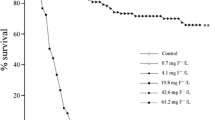Abstract
Tadpoles of Rana temporaria (size 5–7 mm) were kept in solutions of D-penicillamine (DPA), β-aminopropionitril (βAPN), and L-thyroxine at different concentrations for 18 days. The influence of the substances on metamorphosis was investigated.
In low concentrations (1 or 10 mg/100 ml) D-penicillamine accelerates the process of metamorphosis. At these concentrations investigated skeletal malformations could not be observed. A content of 100 mg of DPA/100 ml is toxic. After 8 days of exposure only 4 of the 15 test animals had survived.
In all concentrations investigated, β-aminopropionitril has a toxic action. In low concentration (1 mg/100 ml) deformities are found which could be described as bending of the femur and twisting of the whole hind limb. The animals are non-viable, they die shortly after termination of metamorphosis. Higher concentrations (10 or 100 mg/100 ml) are lethal within the first 10 days.
L-thyroxine (0.01 mg/100 ml) shows the wellknown metamorphosis-accelerating effect.
Zusammenfassung
Kaulquappen von Rana temporaria (5–7 mm groß) wurden 18 Tage in unterschiedlich konzentrierten Lösungen von D-Penicillamin (DPA), β-Aminopropionitril (BAPN) bzw. L-Thyroxin gehalten. Der Einfluß der Substanzen auf die Metamorphose wurde überprüft.
D-Penicillamin beschleunigt in niedrigen Konzentrationen (1 bzw. 10 mg/100 ml) den Ablauf der Metamorphose. Fehlentwicklungen am Skelettsystem sind nicht zu beobachten. Ein Gehalt von 100mg DPA/100 ml ist toxisch. Nach 8tägiger Exposition leben nur noch 4 von 15 der eingesetzten Tiere.
β-Aminopropionitril wirkt in allen geprüften Konzentrationen toxisch. In der niedrigen Konzentration (1 mg/100 ml) sind Veränderungen am Skelettsystem zu erkennen, die als Verbiegung des Femurs und Verdrillung der gesamten Hinterextremität beschrieben werden können. Diese Tiere sind nicht lebensfähig, sie sterben kurz nach Beendigung der Metamorphose. Höhere Konzentrationen (10 bzw. 100 mg/100 ml) wirken innerhalb der ersten 10 Tage letal.
L-Thyroxin (0,01 mg/100 ml) zeigt die bekannte metamorphosebeschleunigende Wirkung.
Similar content being viewed by others
Literatur
Barrow, M. V., Steffek, A. J.: Teratologic and other embryotoxic effects of β-aminopropionitril in rats. Teratology 10, 165–172 (1974)
Chang, C. G.: Teratogenic effects of Lathyrus odoratur seeds on development and regeneration of vertebrate limbs. Proc. Soc. Exp. Biol. Med. 90, 45–50 (1955)
Friedrich, L., Zimmermann, F.: Zur Pharmakologie von D-Penicillamin. Arzneim.-Forsch. (Drug. Res.) 25, 162–168 (1975)
Levy, B.: New method for the rapid determination of lathyrogenic agents. Science 129, 720–721 (1959)
Nimni, M. E.: Accumulation of a collagen precursor in the skin of penicillamine-treated rats. Biochem. biophys. Acta 111, 576–579 (1965)
Nimni, M. E.: Dermalathyrism: A defect in the intramolecular and intermolecular crosslinking of collagen in soft tissues caused by penicillamine. Arthr. and Rheum. 10, 301–307 (1967)
Nimni, M. E., Deshmukh, K.: Chemical and structural differences between collagens from normal penicillamine-treated and lathyritic tissues. Arthr. and Rheum. 11, 110–114 (1968)
Nimni, M. E., Deshmukh, K., Deshmukh, A.: Mechanism of inhibition of collagen crosslinking and depolymerisation of an incompletely crosslinked form of insoluble collagen caused by D-penicillamine. In: Chemistry and molecular biology of the intercellular matrix (E. A. Balazs, Ed.) Volume I; Collagen, Basal Laminae Elastin. London and New York: Academic Press (1970)
Orbison, J. L.: Lathyrism and lathyrogenic substances. In: Popper, H., Becker, K.: Colllagen metabolism in the liver (H. Popper, Ed.). New York: Stratton intercontinental medical Book Corporation 1975
Siegel, R. C., Pinell, S. R., Martin, G. R.: The enzymatic defect in lathyrism. Clin. Res. 18, 136–143 (1970)
Vogel, H. G.: Organ specificity of the effect of D-penicillamine and of lathyrogen (aminoacetonitrile) on mechanical properties of connective and supporting tissue. Arzneim.-Forsch. 24, 157–163 (1974)
Author information
Authors and Affiliations
Rights and permissions
About this article
Cite this article
Friedrich, L., Wuppermann, D. & Zimmermann, F. Influence of D-penicillamine and β-aminopropionitril on the metamorphosis of Rana temporaria . Arch. Toxicol. 35, 181–185 (1976). https://doi.org/10.1007/BF00293565
Received:
Issue Date:
DOI: https://doi.org/10.1007/BF00293565




